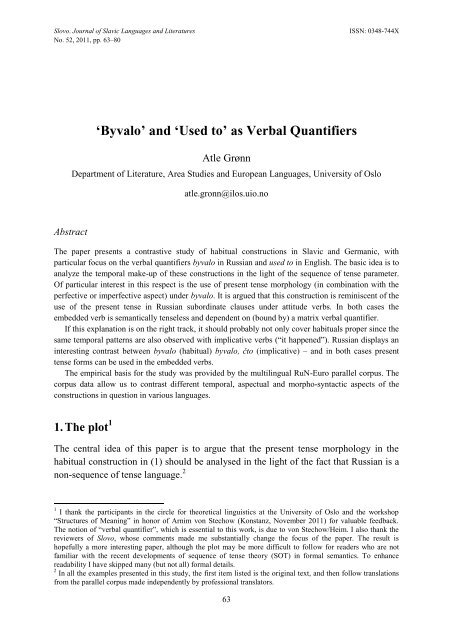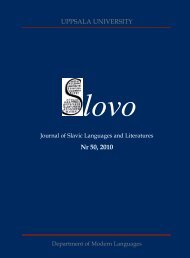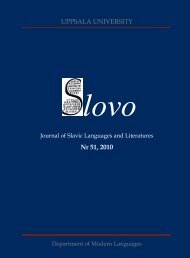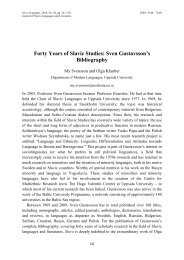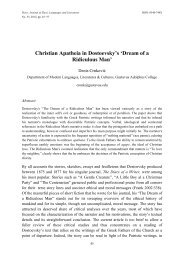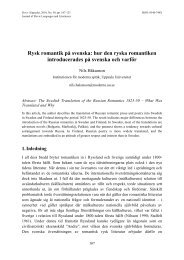Full text PDF - Index of - Uppsala universitet
Full text PDF - Index of - Uppsala universitet
Full text PDF - Index of - Uppsala universitet
You also want an ePaper? Increase the reach of your titles
YUMPU automatically turns print PDFs into web optimized ePapers that Google loves.
Slovo. Journal <strong>of</strong> Slavic Languages and Literatures ISSN: 0348-744X<br />
No. 52, 2011, pp. 63–80<br />
‘Byvalo’ and ‘Used to’ as Verbal Quantifiers<br />
Atle Grønn<br />
Department <strong>of</strong> Literature, Area Studies and European Languages, University <strong>of</strong> Oslo<br />
atle.gronn@ilos.uio.no<br />
Abstract<br />
The paper presents a contrastive study <strong>of</strong> habitual constructions in Slavic and Germanic, with<br />
particular focus on the verbal quantifiers byvalo in Russian and used to in English. The basic idea is to<br />
analyze the temporal make-up <strong>of</strong> these constructions in the light <strong>of</strong> the sequence <strong>of</strong> tense parameter.<br />
Of particular interest in this respect is the use <strong>of</strong> present tense morphology (in combination with the<br />
perfective or imperfective aspect) under byvalo. It is argued that this construction is reminiscent <strong>of</strong> the<br />
use <strong>of</strong> the present tense in Russian subordinate clauses under attitude verbs. In both cases the<br />
embedded verb is semantically tenseless and dependent on (bound by) a matrix verbal quantifier.<br />
If this explanation is on the right track, it should probably not only cover habituals proper since the<br />
same temporal patterns are also observed with implicative verbs (“it happened”). Russian displays an<br />
interesting contrast between byvalo (habitual) byvalo, čto (implicative) – and in both cases present<br />
tense forms can be used in the embedded verbs.<br />
The empirical basis for the study was provided by the multilingual RuN-Euro parallel corpus. The<br />
corpus data allow us to contrast different temporal, aspectual and morpho-syntactic aspects <strong>of</strong> the<br />
constructions in question in various languages.<br />
1. The plot 1<br />
The central idea <strong>of</strong> this paper is to argue that the present tense morphology in the<br />
habitual construction in (1) should be analysed in the light <strong>of</strong> the fact that Russian is a<br />
non-sequence <strong>of</strong> tense language. 2<br />
1 I thank the participants in the circle for theoretical linguistics at the University <strong>of</strong> Oslo and the workshop<br />
“Structures <strong>of</strong> Meaning” in honor <strong>of</strong> Arnim von Stechow (Konstanz, November 2011) for valuable feedback.<br />
The notion <strong>of</strong> “verbal quantifier”, which is essential to this work, is due to von Stechow/Heim. I also thank the<br />
reviewers <strong>of</strong> Slovo, whose comments made me substantially change the focus <strong>of</strong> the paper. The result is<br />
hopefully a more interesting paper, although the plot may be more difficult to follow for readers who are not<br />
familiar with the recent developments <strong>of</strong> sequence <strong>of</strong> tense theory (SOT) in formal semantics. To enhance<br />
readability I have skipped many (but not all) formal details.<br />
2 In all the examples presented in this study, the first item listed is the original <strong>text</strong>, and then follow translations<br />
from the parallel corpus made independently by pr<strong>of</strong>essional translators.<br />
63


